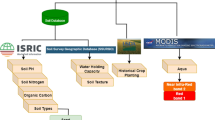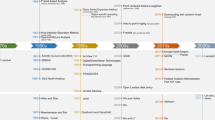Abstract
This article presents several case studies in southwest Germany, which aimed to support land use management decisions by a process-oriented statistical upscaling of point-related environmental monitoring data to the landscape scale. When techniques of data subsetting were used in a sensible way and corresponding to the appropriate scale for the evaluation envisaged, multiple linear regression offered a data mining technique which was able to spatially predict relatively complex environmental patterns with parsimonious, interpretable and accurate models, whereby different evaluation scales were best represented by different DTM resolutions. Scenario models based upon the regression formulas were a valuable tool for visualizing management options and evaluating management impacts (tree species selection) on soil functions (carbon storage), which qualifies the presented methodology as a useful aid in decision making. Such upscaling techniques may be used for forecasting long-term effects of ecosystem management, but they provided no information on temporal dynamics. Therefore, time trends of point information on soil solution data were scaled by linking them to soil chemical data which was available in higher spatial resolution, using both statistical and process-oriented methods.









Similar content being viewed by others
References
Anderson MC, Kustas WP, Norman JM (2003) Upscaling and downscaling—a regional view of the soil–plant–atmosphere continuum. Agronomy Journal 95:1408–1423
Band LE, Moore ID (1995) Scale: landscape attributes and geographical information systems. Hydrological Processes 9:401–422
Baritz R, Rovira, P, Romanya, J, Eerlandsson M, Van Ranst E, Zirlewagen D (2005) Validated, representative soil carbon profiles under forest vegetation. Part I final report for deliverable 3.1. Multi-source inventory methods for quantifying carbon stocks and stock changes in European forests (CarboInvent)
Becher G (1999) Waldzustandsanalyse mit multivariaten Verfahren: theoretische Grundlagen und Anwendungen. Springer, Berlin, Heidelberg, NY
Behrens T, Scholten T (2006) Digital soil mapping in Germany––a review. Journal of Plant Nutrition and Soil Science 169:434–443
Behrens T, Scholten T (2007) A comparison of data-mining techniques in predictive soil mapping. Developments in Soil Science 31:353–364
Berger TW (2007) Benefits of a conversion from secondary coniferous forests to mixed broadleaved stands for soil and water quality––results of selected case studies. In: Dedrick S, Spiecker H, Orazio C, Tomé M, Martinez I (eds) Plantation or conversion––the debate! European forest institute. Joensuu, Finland, pp 39–42
Berger TW, Neubauer C, Glatzel G (2002) Factors controlling soil carbon and nitrogen stores in pure stands of Norway spruce (Picea abies) and mixed species stands in Austria. Forest Ecology and Management 159:3–14
Bierkens MFP, Finke PA, de Willigen P (2000) Upscaling and downscaling methods for environmental research. Kluwer Academic Publishers, Dordrecht
Bishop TFA, Minasny B (2006) Digital soil-terrain modeling: the predictive potential and uncertainty. In: Grunwald S (ed) Environmental soil-landscape modeling: geographic information technologies and pedometrics. Taylor & Francis, London, pp 185–213
Blöschl G, Sivapalan M (1995) Scale issues in hydrological modelling: a review. Hydrological Processes 9:251–290
BML Bundesministerium für Ernährung, Landwirtschaft und Forsten (1990) Bund-/Länderarbeitsgruppe BZE: Bundesweite Bodenzustandserhebung im Wald. BZE, Arbeitsanleitung
Claessens L, Heuvelink GBM, Schoorl JM, Veldkamp A (2005) DEM resolution effects on shallow landslide hazard and soil redistribution modelling. Earth Surface Processes and Landforms 30:461–477
Conacher A, Dalrymple J (1977) The nine unit landsurface model: an approach to pedogeomorphic research. Geoderma 18:1–153
Finzi AC, van Breemen N, Canham CD (1998) Canopy tree-soil interactions within temperate forests; species effects on soil carbon and nitrogen. Ecological Applications 8:440–446
Gapon EN (1933) Theory of exchange adsorption in soils. Russian Journal of General Chemistry 3:144–152
Giasson E, Figueiredo SR, Tornquist CG, Clarke RT (2008) Digital soil mapping using logistic regression on terrain parameters for several ecological regions in southern Brazil. In: Hartemink A, McBratney A, Mendonça-Santos ML (eds) Digital soil mapping with limited data. Springer, NY, pp 225–232
Gobin A, Campling P, Feyen J (2001) Soil-landscape modeling to quantify spatial variability of soil texture. Physics and Chemistry of the Earth Part B 26:41–45
Grunwald S (2006) What do we really know about the space-time continuum of soil-landscapes? In: Grunwald S (ed) Environmental soil-landscape modeling: geographic information technologies and pedometrics. Taylor & Francis, London, pp 3–36
Gültlinger M, Schleyer A, Spohrer M (2001) Flächendeckendes, hochgenaues DGM von Baden-Württemberg. Mitteilungen des Vereins für Vermessungswesen 48:63–77
Hastie T, Tibshirani R, Friedman JH (2001) The elements of statistical learning––data mining, inference and prediction. Springer, New York
Hengl T (2003) Pedometric mapping––bridging the gaps between conventional and pedometric approaches. Thesis Wageningen University, Enschede
Hengl T (2007) A practical guide to geostatistical mapping of environmental variables. Joint Research Centre-Institute for the Environment and Sustainability, Italy
Hengl T, Heuvelink GBM, Rossiter DG (2007) About regression-kriging: from equations to case studies. Computers and Geosciences 33:1301–1315
Hildebrand EE (1994) The heterogeneous distribution of mobile ions in the rhizosphere of acid forest soils: facts, causes and consequences. Journal of Environmental Science and Health A29(9):1973–1992
ICP Forests (1998) Manual on methods and criteria for harmonized sampling, assessment, monitoring and analysis of the effects of air pollution on forests. http://www.icp-forests.org
Isaaks E, Srivastava RM (1989) An introduction into applied geostatistics. Oxford university press, Oxford
Jandl R, Lindner M, Vesterdal L, Bauwens B, Baritz R, Hagedorn F, Johnson DW, Minkkinen K, Byrne KA (2007) How strongly can forest management influence soil carbon sequestration? Geoderma 137:253–268
Jarvis PG (1995) Scaling processes and problems. Plants, Cell and Environment 18:1079–1089
Klimo E, Kulhavý J (2006) Norway spruce monocultures and their transformation to close-to-nature forests from the point of view of soil changes in the Czech Republic. Ekológia 25:27–43
Lal R (2001) The potential of soil carbon sequestration in forest ecosystems to mitigate the greenhouse effect. SSSA Special Publication 57:137–154
Lal R (2005) Forest soils and carbon sequestration. Forest Ecology and Management 220:242–258
Lesná J, Kulhavý J (2003) Evaluation of humus conditions under different forest stands: beech vs. spruce dominated forest stand. Ekológia 22:47–60
MacMillan R, Pettapiece W, Nolanc S, Goddard T (2000) A generic procedure for automatically segmenting landforms into landform elements using DEMs, heuristic rules and fuzzy logic. Fuzzy Sets and Systems 81:81–109
McBratney AB, Odeh IOA, Bishop TFA, Dunbar MS, Shatar TM (2000) An overview of pedometric techniques for use in soil survey. Geoderma 97:293–327
McBratney AB, Mendonça-Santos ML, Minasny B (2003) On digital soil mapping. Geoderma 117:3–52
McKenzie NJ, Ryan PJ (1999) Spatial prediction of soil properties using environmental correlation. Geoderma 89:67–94
McKenzie NJ, Gessler PE, Ryan PJ, O’Connell DA (2000) The role of terrain analysis in soil mapping. In: Wilson J, Gallant J (eds) Terrain analysis: principles and applications. John Wiley and Sons, New York City, NY, pp 245–265
Miller DM (1984) Reducing transformation bias in curve fitting. The American Statistician 38:124–126
Möller M, Volk M, Friedrich K, Lymburner L (2008) Placing soil-genesis and transport processes into a landscape context: a multiscale terrain-analysis approach. Journal of Plant Nutrition and Soil Science 171:419–430
Moore ID, Grayson RB, Ladson AR (1991) Digital terrain modelling: a review of hydrological, geomorphological and biological applications. Hydrological Processes 5:3–30
Odeh IOA, McBratney AB (2000) Using AVHRR images for spatial prediction of clay content in the lower Namoi Valley of eastern Australia. Geoderma 97:237–254
Odeh IOA, McBratney AB, Chittleborough DJ (1995) Further results on prediction of soil properties from terrain attributes: heterotopic cokriging and regression-kriging. Geoderma 67:215–225
Pebesma EJ (2006) The role of external variables and GIS databases in geostatistical analysis. Transactions in GIS 10:615–632
Rasmussen C, Southard RJ, Horwath WR (2007) Soil mineralogy affects conifer forest soil carbon source utilization and microbial priming. Soil Science Society of America Journal 71:1141–1150
Rothe A (1997) Einfluss des Baumartenanteils auf Durchwurzelung, Wasserhaushalt, Stoffhaushalt und Zuwachsleistung eines Fichten-Buchen-Mischbestandes am Standort Höglwald. Forstliche Forschungsberichte München 163
Ryan PJ, McKenzie NJ, O’Connell D, Loughhead AN, Leppert PM, Jacquier D, Ashton L (2000) Integrating forest soils information across scales: spatial prediction of soil properties under Australian forests. Forest Ecology and Management 138:139–157
Saborowski J, Jansen M (2002) Statistical methods for regionalization of ecological state variables. In: Jansen M, Judas M, Saborowski J (eds) Spatial modelling in forest ecology and management. Springer, Berlin, pp 19–26
SAS Institute Inc (2004) SAS OnlineDoc® 9.1.3. SAS Institute Inc, Cary, NC
Schabenberger O, Pierce FJ (2002) Contemporary statistical models for the plant and soil sciences. Taylor & Francis, New York
Schall P, Seidling W (2004) Up-scaling of results from forest ecosystem monitoring to the large-scale. UN/ECE, Geneva
Schmidt J, Hewitt A (2004) Fuzzy land element classification from DTMs based on geometry and terrain position. Geoderma 121:243–256
Schoorl JM, Veldkamp A (2006) Multiscale soil-landscape process modeling. In: Grunwald S (ed) Environmental soil-landscape modeling: geographic information technologies and pedometrics. Taylor & Francis, London, pp 417–435
Schulp CJE, Veldkamp A (2008) Long-term landscape––land use interactions as explaining factor for soil organic matter variability in Dutch agricultural landscapes. Geoderma 146:457–465
Scull P, Franklin J, Chadwick OA, McArthur D (2003) Predictive soil mapping: a review. Progress in Physical Geography 27:171–197
Speight J (1988) Land classification. In: Gunn R, Beattie J, Reid R, van der Graaff R (eds) Australian soil land survey handbook––guidelines for conducting surveys. Inkata Press, Melbourne, pp 38–59
Steinhardt U, Volk M (2003) Meso-scale landscape analysis based on landscape balance investigations: problems and hierarchical approaches for their resolution. Ecological modelling 168:251–265
Sucker C, Puhlmann H, Zirlewagen D, von Wilpert K, Feger KH (2009) Bodenschutzkalkungen in Wäldern zur Verbesserung der Wasserqualität. Vergleichende Untersuchungen auf Einzugsgebietsebene. Hydrologie und Wasserbewirtschaftung 53:250–262
Underwood N, Hambäck P, Inouye BD (2005) Large-scale questions and small-scale data: empirical and theoretical methods for scaling up in ecology. Oecologia 145:177–178
Van der Gun J, Vasak S, Reckman J (2008) Hydrogeological zoning: From local to global scales. International geological congress abstracts 33, Abstract 1341843
Vesterdal L, Schmidt IK, Callesen I, Nilsson LO, Gundersen P (2008) Carbon and nitrogen in forest floor and mineral soil under six common European tree species. Forest Ecology and Management 255:35–48
Von Wilpert K, Zirlewagen D, Kohler M (2000) To what extent can silviculture enhance sustain-ability of forest sites under the immission regime in Central Europe? Water, Air, and Soil pollution 122:105–120
Ziadat FM (2005) Analyzing digital terrain attributes to predict soil attributes for a relatively large area. Soil Science Society of America Journal 69:1590–1599
Zirlewagen D, von Wilpert K (2001) Modeling water and ion fluxes in a highly structured, mixed-species stand. Forest Ecology and Management 143:27–37
Zirlewagen D, von Wilpert K (2004) Using model scenarios to predict and evaluate forest management impacts on soil base saturation at landscape level. European Journal of Forest Research 123:269–282
Zirlewagen D, von Wilpert K (2009) Spatio-temporal patterns of matter fluxes in soils: linkage between soil solution and soil solid phase. Waldökologie, Landschaftsforschung und Naturschutz 8:30–39
Zirlewagen D, Raben G, Weise M (2007) Zoning of forest health conditions based on a set of soil, topographic and vegetation parameters. Forest Ecology and Management 248:43–55
Acknowledgments
This study was funded by the EU INTERREG III A-project No. 2c.11, the BioSoil regulation, the Baden-Württemberg soil monitoring program and the Federal Ministry for Education and Research (BMBF No. 0330634 K) as part of the joint project “Environment and Forests under Changing Conditions” (ENFORCHANGE) of the program “Research for Sustainability”.
Author information
Authors and Affiliations
Corresponding author
Rights and permissions
About this article
Cite this article
Zirlewagen, D., von Wilpert, K. Upscaling of Environmental Information: Support of Land-Use Management Decisions by Spatio-Temporal Regionalization Approaches. Environmental Management 46, 878–893 (2010). https://doi.org/10.1007/s00267-010-9468-4
Received:
Accepted:
Published:
Issue Date:
DOI: https://doi.org/10.1007/s00267-010-9468-4




